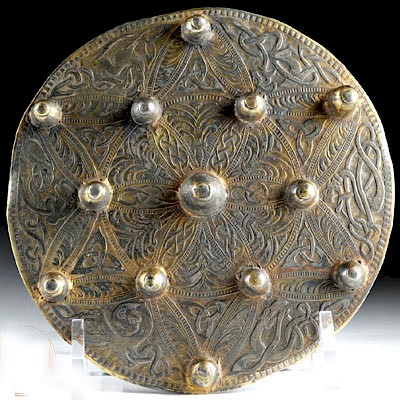18th C. Wedgwood Cameo - Apollo Playing Lyre
Lot 137
About Seller
Artemis Fine Arts
686 S Taylor Ave, Ste 106
Louisville, CO 80027
United States
Selling antiquities, ancient and ethnographic art online since 1993, Artemis Gallery specializes in Classical Antiquities (Egyptian, Greek, Roman, Near Eastern), Asian, Pre-Columbian, African / Tribal / Oceanographic art. Our extensive inventory includes pottery, stone, metal, wood, glass and textil...Read more
Estimate:
$600 - $900
Absentee vs Live bid
Two ways to bid:
- Leave a max absentee bid and the platform will bid on your behalf up to your maximum bid during the live auction.
- Bid live during the auction and your bids will be submitted real-time to the auctioneer.
Bid Increments
| Price | Bid Increment |
|---|---|
| $0 | $25 |
| $300 | $50 |
| $1,000 | $100 |
| $2,000 | $250 |
| $5,000 | $500 |
| $10,000 | $1,000 |
| $20,000 | $2,500 |
| $50,000 | $5,000 |
| $100,000 | $10,000 |
| $200,000 | $20,000 |
About Auction
By Artemis Fine Arts
Jul 19, 2018
Set Reminder
2018-07-19 10:00:00
2018-07-19 10:00:00
America/New_York
Bidsquare
Bidsquare : Fine Antiquities/Ethnographic Art
https://www.bidsquare.com/auctions/artemis-gallery/fine-antiquities-ethnographic-art-3329
Featuring classical antiquities, ancient and ethnographic art from cultures encompassing the globe, plus fine art. Artemis Fine Arts info@artemisfinearts.com
Featuring classical antiquities, ancient and ethnographic art from cultures encompassing the globe, plus fine art. Artemis Fine Arts info@artemisfinearts.com
- Lot Description
Europe, England, ca. 18th to 19th century CE. A beautiful and large genuine, presumably Wedgwood oval cameo comprised of black or deep blue jasperware and creamy white relief to depict Apollo - the god of music, poetry, art, and knowledge - youthful and in the nude, sitting upon fabric that billows over a throne or rocky outcrop. Note how skillfully the sculptor deliated the musculature of the deity's athletic body, the drapery folds beneath Apollo, and the lyre that he is holding upon his right thigh. A wonderful example of Neoclassical wearable art created by Wedgwood. Size: 1.5" L x 1.25" W (3.8 cm x 3.2 cm)
According to the Wedgewood Museum, "Cameos, where the design is in relief, were described by Josiah in his 1779 Catalogue of Ornamental Wares as suitable for rings, buttons, lockets, bracelets and inlaying into furniture. However, they came to be used in an even greater variety of ways than Josiah enumerated: on clock cases and pendulums, chatelaines, watch cases and keys, snuff-, patch- and work-boxes, needle- and toothpick-cases, writing desks and sword hilts, metal vases, urns and lamps, perfume bottles, opera glasses and coach panels." (http://www.wedgwoodmuseum.org.uk/learning/discovery-packs/pack/classical/chapter/cameos-and-medallions)
Many of the ancient Greek themes, like the Apollo on this Wedgwood item stem from the contributions by the Adams family - Scottish architects and artists - the most famous being Robert Adams who was the Architect of the King's Works from 1761 to 1769. The Adams family championed Neoclassicism in 18th century England.
Provenance: private East Coast, USA collection
All items legal to buy/sell under U.S. Statute covering cultural patrimony Code 2600, CHAPTER 14, and are guaranteed to be as described or your money back.
A Certificate of Authenticity will accompany all winning bids.
We ship worldwide and handle all shipping in-house for your convenience.
#133100Intact with minor surface wear commensurate with age, but generally excellent.Condition
- Shipping Info
-
All shipping is handled in-house for your convenience. Your invoice from Artemis Gallery will include shipping calculation instructions. If in doubt, please inquire BEFORE bidding for estimated shipping costs for individual items.
-
- Buyer's Premium



 EUR
EUR CAD
CAD AUD
AUD GBP
GBP MXN
MXN HKD
HKD CNY
CNY MYR
MYR SEK
SEK SGD
SGD CHF
CHF THB
THB















